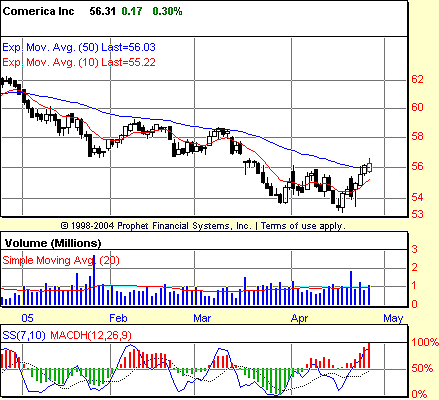
HOT TOPICS LIST
- MACD
- Fibonacci
- RSI
- Gann
- ADXR
- Stochastics
- Volume
- Triangles
- Futures
- Cycles
- Volatility
- ZIGZAG
- MESA
- Retracement
- Aroon
INDICATORS LIST
LIST OF TOPICS
PRINT THIS ARTICLE
by David Penn
Bulls longing for a bottom in the markets get optimistic signs from banks responding to positive divergences.
Position: N/A
David Penn
Technical Writer for Technical Analysis of STOCKS & COMMODITIES magazine, Working-Money.com, and Traders.com Advantage.
PRINT THIS ARTICLE
STOCHASTICS
Bouncing Banks
04/27/05 10:35:06 AMby David Penn
Bulls longing for a bottom in the markets get optimistic signs from banks responding to positive divergences.
Position: N/A
| One of the things that have stymied many of those looking for an end to the declines that have characterized the markets in the spring of 2005 is leadership--or rather, the lack of it. "Leading stocks in leading sectors," for example, is the mantra for more than a few technical analysts. These technicians know that if the market is to move appreciably higher, then it will be some cohort of like stocks that will have to do the first, heaviest work. |
| In recent years, investors and traders have looked to two places for this kind of leadership: technology and financials. The reasons for this are straightforward enough: technology is still seen as "the" growth area in the economy, and investors looking for capital appreciation in their shares will want to invest in companies that are growing and growing at a rapid clip. Financials are the lifeblood of the 21st century, credit-fueled economy and, as such, are extremely sensitive to the availability of and demand for money--as well as the fiscal health of those doing the lending and borrowing. |

|
| Figure 1: The trading in Comerica is typical of those financials that bottomed in April with positive divergences and are currently fighting to advance and remain above their 50-day EMAs. |
| Graphic provided by: Prophet Financial, Inc. |
| |
| I keep a roster of 20-odd banks that I follow--mostly those that are components of the regional bank HOLDRS, as well as some of the bigger national (or even global) names like Citigroup, Bank of America, and JP Morgan Chase. Of this cohort, four produced bottoms in March after clear positive stochastic divergences. Twelve of these financial stocks -- including Comerica, as shown in Figure 1 -- produced or are producing bottoms in April, also after clear positive stochastic divergences. |
| Whether these positive divergences will have anticipated a new leg up for this sector (and, perhaps, for the broader market, as well) remains to be seen. Again, as I have been pointing out recently, positive divergences clearly suggest that the downside is limited--which may or may not mean that a profitable trade to the long side is to be had. Consider, for example, the fate of Wells Fargo, one of four financials in my list to form a positive stochastic divergence in March. |
| Wells Fargo (WFC) developed a positive stochastic divergence in late March--a divergence that appeared simultaneously with another bullish development: a piercing pattern. Closing at about 58.75 on that day, WFC went on to rally to an intraday high of nearly 61. However, WFC failed to take out the previous month's high north of 61 and, instead, found its rally developing a negative stochastic divergence as WFC forced its way back up above the 50-day exponential moving average (EMA). That negative stochastic divergence was the rally's undoing, as the advance peaked out in mid-April and began to retreat, eventually closing below levels previously reached in March. |
Technical Writer for Technical Analysis of STOCKS & COMMODITIES magazine, Working-Money.com, and Traders.com Advantage.
| Title: | Technical Writer |
| Company: | Technical Analysis, Inc. |
| Address: | 4757 California Avenue SW |
| Seattle, WA 98116 | |
| Phone # for sales: | 206 938 0570 |
| Fax: | 206 938 1307 |
| Website: | www.Traders.com |
| E-mail address: | DPenn@traders.com |
Traders' Resource Links | |
| Charting the Stock Market: The Wyckoff Method -- Books | |
| Working-Money.com -- Online Trading Services | |
| Traders.com Advantage -- Online Trading Services | |
| Technical Analysis of Stocks & Commodities -- Publications and Newsletters | |
| Working Money, at Working-Money.com -- Publications and Newsletters | |
| Traders.com Advantage -- Publications and Newsletters | |
| Professional Traders Starter Kit -- Software | |
Click here for more information about our publications!
Comments
Date: 04/27/05Rank: 4Comment:

|

Request Information From Our Sponsors
- StockCharts.com, Inc.
- Candle Patterns
- Candlestick Charting Explained
- Intermarket Technical Analysis
- John Murphy on Chart Analysis
- John Murphy's Chart Pattern Recognition
- John Murphy's Market Message
- MurphyExplainsMarketAnalysis-Intermarket Analysis
- MurphyExplainsMarketAnalysis-Visual Analysis
- StockCharts.com
- Technical Analysis of the Financial Markets
- The Visual Investor
- VectorVest, Inc.
- Executive Premier Workshop
- One-Day Options Course
- OptionsPro
- Retirement Income Workshop
- Sure-Fire Trading Systems (VectorVest, Inc.)
- Trading as a Business Workshop
- VectorVest 7 EOD
- VectorVest 7 RealTime/IntraDay
- VectorVest AutoTester
- VectorVest Educational Services
- VectorVest OnLine
- VectorVest Options Analyzer
- VectorVest ProGraphics v6.0
- VectorVest ProTrader 7
- VectorVest RealTime Derby Tool
- VectorVest Simulator
- VectorVest Variator
- VectorVest Watchdog
